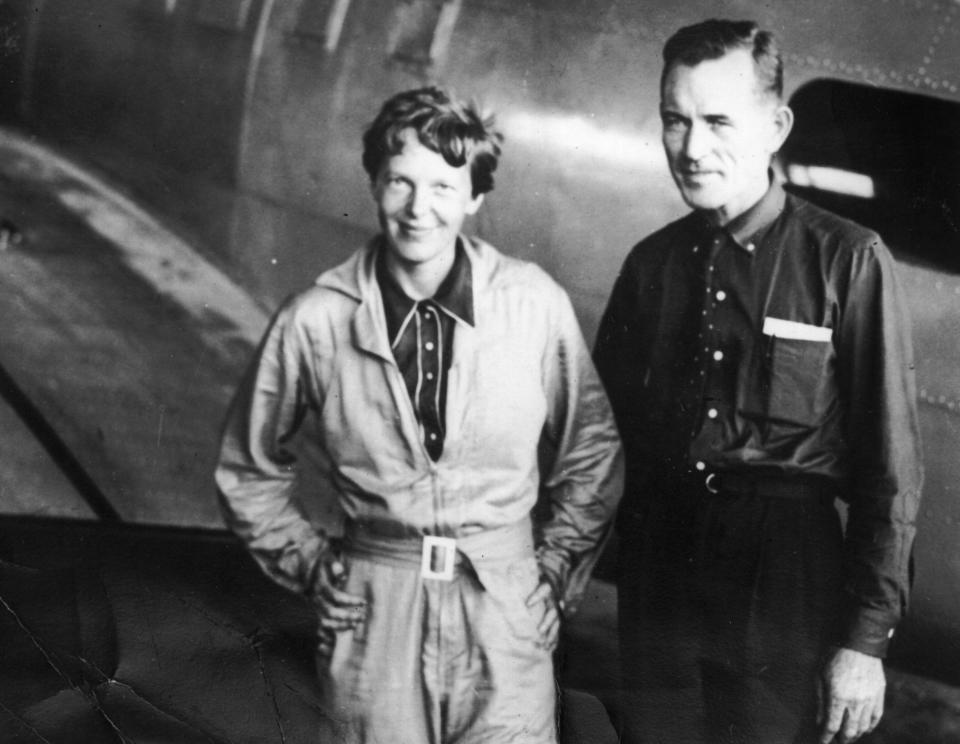Many hoped it was Amelia Earhart's missing plane. It turned out to be a rock formation
In January, an ocean exploration company published a photo of what it said could be the wreckage of the plane flown by pioneering aviator Amelia Earhart when she disappeared in 1937 while attempting to fly around the world.
The news gained international attention as it suggested a possible bookend to one of the greatest unsolved mysteries of the 20th century. Eleven months later, the company has identified the plane-like object as a rock formation – not the crashed plane of one of the most important figures in aviation history.
"After 11 months the waiting has finally ended and unfortunately our target was not Amelia's Electra 10E (just a natural rock formation)," the company, Deep Sea Vision, wrote in an Instagram post on Nov. 6.

The image was taken by an advanced underwater drone that scanned 5,200 square miles of seafloor in the Pacific, the South Carolina-based company said in a statement earlier this year. It spotted the formation within 100 miles of Howland Island, between the Hawaiian Islands and Australia, where Earhart and her navigator, Fred Noonan, were expected to land before they vanished.
Despite the disappointing result, Deep Sea Vision vowed to forge ahead with its dep-sea search. It did not respond to USA TODAY's request for comment.
"As we speak DSV continues to search - now clearing almost 7700 square miles... the plot thickens with still no evidence of her disappearance ever found ... let us know what you think – did she run out of gas near Howland Island?" Deep Sea Vision said on social media.

Who was Amelia Earhart?
Earhart was born in Atchison, Kansas, on July 24, 1897. She served as a Red Cross nurse's aide in Canada during World War I, where she spent time watching pilots train. After the war, she briefly studied at Columbia University as a premed student before she dropped out and moved to California where her parents lived, according to the Federal Aviation Administration.
In 1920, she rode in an airplane for the first time and soon began taking flying lessons, which she paid for with money she earned from odd jobs, according to the FAA. She got her pilot's license and within a year went on to set a women’s altitude record, reaching the height of 14,000 feet in October 1922.
In 1932, she flew from Newfoundland to Northern Ireland, making her the first woman to fly solo across the Atlantic Ocean, according to the FAA. She then ventured on a solo flight across the United States and others that took her from Hawaii to California and Mexico City and New York.
It was in 1936 that she started planning her most ambitious journey yet – a flight around the world.
What happened to Amelia Earhart?
Earhart and Noonan, departed from Oakland, California, on May 20, 1937, on a Lockheed Electra aircraft. According to the International Group for Historic Aircraft Recovery, they made 29 additional stops, including their last known refuel stop in Lae, New Guinea, on July 2 at 10 a.m. local time.
Nearing the end of their historic trip, Earhart and Noonan were due on Howland Island – about 2,500 miles away from Lae – where U.S. Coast Guard cutter Itasca was waiting for them with fuel.
Itasca received intermittent voice messages from Earhart as her signal increased. But neither Earhart nor Noonan knew Morse code, so there was no two-way contact, according to the Smithsonian Institute’s analysis of government records.
After losing contact, the Navy and Coast Guard searched about 250,000 square miles of ocean in search of Earhart and Noonan. The unsuccessful endeavors, which lasted until until October 1937, cost roughly $250,000 per day, TIME reported.
On Jan. 5, 1939, they were declared legally dead.
Theories about disappearance abound
Since Earhart and Noonan vanished, a variety of theories about their disappearance have emerged. The most widely accepted explanation is Earhart and Noonan ran out of fuel and crashed in the ocean.
Elgin and Marie Long wrote the book "Amelia Earhart: The Mystery Solved" in which they posit just that. Earhart and Noonan, they write, likely burned through their fuel as they encountered bad weather on their way to Howland Island. They cited Earhart's voice as she tried to locate the ship assigned to assist the pair on their attempted flight around the world.
In some of the more implausible scenarios, theorists say the flight was part of a secret spy mission, that Earhart assumed another identity or that Earhart and Noonan were captured by a foreign government.

In another theory, they crash landed not in the Pacific Ocean but on the remote, uninhabited Nikumaroro Atoll, an island about 400 miles south of Howland.
Another theory says that Earhart crash-landed on the Marshall Islands and was taken captive by the Japanese authorities. Fans of this scenario often point to a photo from the U.S. National Archives that shows a woman and man who resemble Earhart and Noonan. Japanese authorities have said there are no records indicating she was in custody.
“That’s just nonsense,” Dorothy Cochrane, a curator in the aeronautics department of the Smithsonian Institution’s National Air and Space Museum, told the Wall Street Journal when asked about the far-fetched theories. “None of that is practical.”
As multimillion dollar searches for the infamous plane continue, many are waiting for a resolution to one of the most enduring mysteries in modern history.
"I had high hopes about this one. The formation is astonishing!" one Facebook user wrote on Deep Sea Vision's post announcing the discovery was a rock formation. "It certainly was VERY similar to her plane. I've been waiting anxiously for updates! Thank you for never giving up."
Contributing: Saman Shafiq, USA TODAY
This article originally appeared on USA TODAY: Amelia Earhart's missing plane? No, they are rocks on the ocean floor
Solve the daily Crossword

